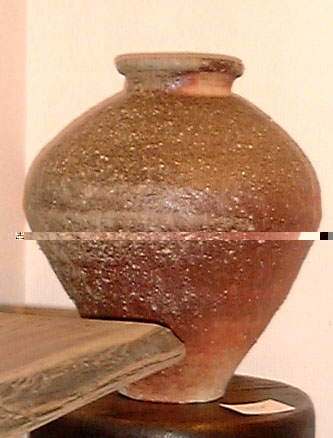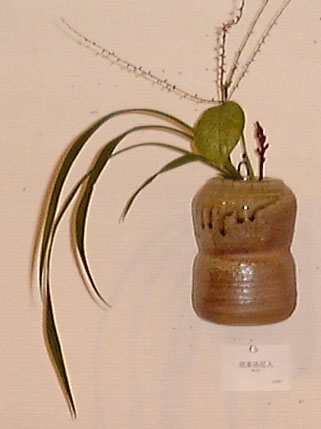|
LEARN MORE
Japan Times Story on Abe Hitoshi
Sake Vessels
by Abe Hitoshi

Yellin's gallery
sells pieces from
the kilns of Japan's
finest potters
|
|
|
Abe Hitoshi
Exhibition Review
at Plaza Hotel Annex Gallery in Mishima
October 2001
|
Abe Hitoshi first came to pottery, like Rosanjin, in the kitchen. He used to be a chef at Kicho, one of Japan's premier ryotei (upscale Japanese restaurant). In that kitchen he used Rosanjin's dishes as well as some fine antique Shino wares and all types of porcelain. After leaving Kicho he set up a kiln in Ohito, which is a small town in the Izu peninsula (click here for more about Izu). The beauty and natural surroundings of Izu have been an inspiration for Abe ever since.
Recently Abe held an exhibition in Mishima. Mishima is a gateway to the Izu peninsula and also the name of a style of pottery (click here for related story by Robert Yellin published in the Japan Times).
In addition, the Grand Shrine of Mishima was made famous in many ukiyo-e prints (woodblock prints), most notably by Hiroshige. Below is Hiroshige's rendition of the Grand Shrine of Mishima (available for sale at the Carolyn Staley Prints web site).
Abe's work is solid but nothing that will change the ceramic scene of Japan. Like thousands of potters in Japan, Abe has a local following and although he does exhibit in Tokyo and Osaka, he does best closer to home.
Sticking with traditional shapes and glazes, Abe works best in Shigaraki and Shino wares. Getting those local clays isn't a problem anymore as there are plenty of clay dealers that ship anywhere in Japan, even to remote places like Izu. Abe does occasionally drive to Gifu to dig his own clay and he did that for these Shino mukozuke (small dishes).
They were fired in Abe's anagama and were a bit on the over-fired side as the iron underglaze paintings came on a bit too strong.
What did work better were his chawan, especially his Shino-hakeme chawan (1st photo below) and his Hori Shigaraki (carved Shigaraki) with a swipe of hakeme on the front (2nd photo below).
Both sat comfortably in the hands and had a power in them that reminded me of Kato Tokuro; he said his chawan were like little castles.
Abe whips up a bowl of macha at home sitting around his irori (hearth) set in his Edo-period home. The room is full of shadows and calls to mind passages from Tanizaki Junichiro's aesthetic essay "In Praise of Shadows," a book that should be read by all lovers of Japanese art.
For years now Abe has been trying to his hand at using clay for wall hangings and he showed a few this time around. As one entered the exhibition hall these sets were on the front wall.
You can see a small gathering in the wider photo shown below.
I don't think many folks paid them much mind for they did lack in balance and harmony I thought.
That wasn't the case for this rather large kogo incense case (below photo).
It was the largest one I've ever seen and had a pale greenish ash glaze gracing the front and hi-iro fire colors on the back. I was tempted to buy it and probably will as it lingered in my mind for days. That's one of the criteria for anything of lasting value -- whether it be a movie, a new friend, or a pot.
Other pieces were a standard large Shigaraki tsubo-jar (1st photo below), a nice kakehanire (hanging vase, 2nd below), a warped incised Shigaraki platter (3rd below), and of course some very fine shuki (sake utensils, 4th below).
 |
 |
 |
 |
Abe, being the fine chef he is, also takes his drink -- and what he serves it in -- quite seriously. Always a good sign for a potter whether they make shuki or shokki (tablewares). I can usually tell by looking at works if the potter drinks-cooks or not. Can't fool an old fool.
I've been following Abe's work for close to twenty years now. He's had his ups and downs but I feel he's getting back into a "centered and balanced" phase. After what I thought was a mediocre addition to the TOH one-hundred book series, showing his forgetable objet d'art a few years back, he's returning to the basics that he learned at Kicho; keeping it simple and clean yet full of subtle flavors. His forming and baking still continue in his own kitchen and in his studio set amidst nature's cathedral, an ethereal bamboo grove.
story by Robert Yellin
LEARN MORE ABOUT ABE HITOSHI
|
|
|
|
|